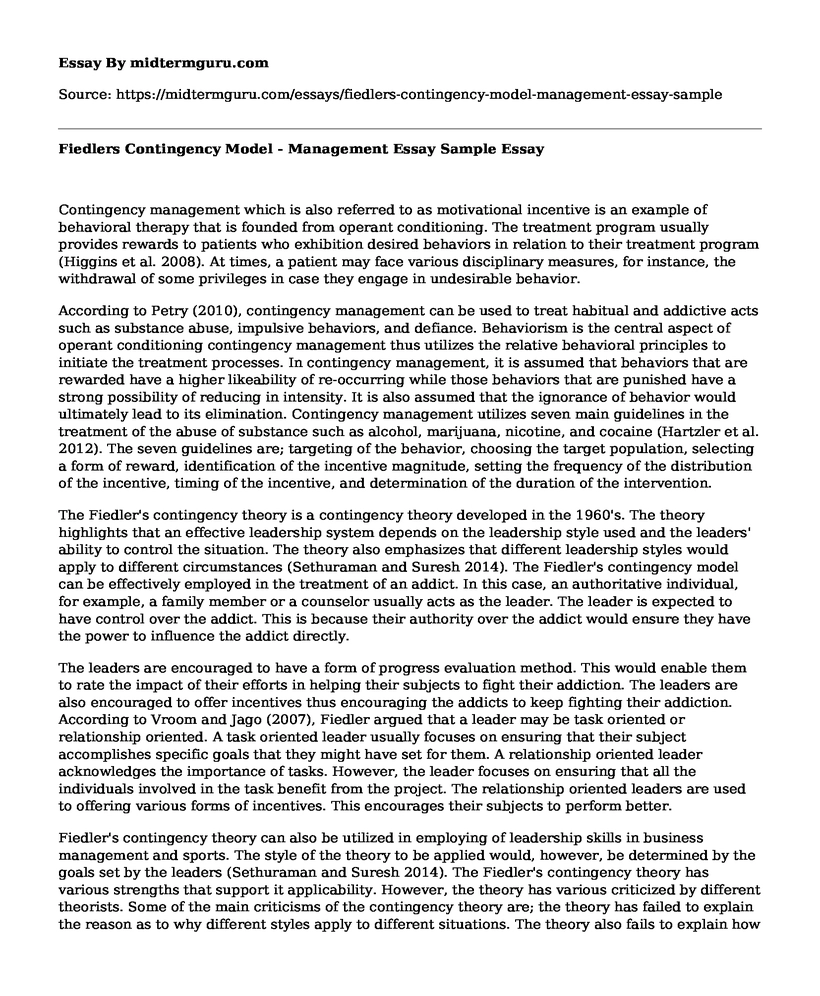Contingency management which is also referred to as motivational incentive is an example of behavioral therapy that is founded from operant conditioning. The treatment program usually provides rewards to patients who exhibition desired behaviors in relation to their treatment program (Higgins et al. 2008). At times, a patient may face various disciplinary measures, for instance, the withdrawal of some privileges in case they engage in undesirable behavior.
According to Petry (2010), contingency management can be used to treat habitual and addictive acts such as substance abuse, impulsive behaviors, and defiance. Behaviorism is the central aspect of operant conditioning contingency management thus utilizes the relative behavioral principles to initiate the treatment processes. In contingency management, it is assumed that behaviors that are rewarded have a higher likeability of re-occurring while those behaviors that are punished have a strong possibility of reducing in intensity. It is also assumed that the ignorance of behavior would ultimately lead to its elimination. Contingency management utilizes seven main guidelines in the treatment of the abuse of substance such as alcohol, marijuana, nicotine, and cocaine (Hartzler et al. 2012). The seven guidelines are; targeting of the behavior, choosing the target population, selecting a form of reward, identification of the incentive magnitude, setting the frequency of the distribution of the incentive, timing of the incentive, and determination of the duration of the intervention.
The Fiedler's contingency theory is a contingency theory developed in the 1960's. The theory highlights that an effective leadership system depends on the leadership style used and the leaders' ability to control the situation. The theory also emphasizes that different leadership styles would apply to different circumstances (Sethuraman and Suresh 2014). The Fiedler's contingency model can be effectively employed in the treatment of an addict. In this case, an authoritative individual, for example, a family member or a counselor usually acts as the leader. The leader is expected to have control over the addict. This is because their authority over the addict would ensure they have the power to influence the addict directly.
The leaders are encouraged to have a form of progress evaluation method. This would enable them to rate the impact of their efforts in helping their subjects to fight their addiction. The leaders are also encouraged to offer incentives thus encouraging the addicts to keep fighting their addiction. According to Vroom and Jago (2007), Fiedler argued that a leader may be task oriented or relationship oriented. A task oriented leader usually focuses on ensuring that their subject accomplishes specific goals that they might have set for them. A relationship oriented leader acknowledges the importance of tasks. However, the leader focuses on ensuring that all the individuals involved in the task benefit from the project. The relationship oriented leaders are used to offering various forms of incentives. This encourages their subjects to perform better.
Fiedler's contingency theory can also be utilized in employing of leadership skills in business management and sports. The style of the theory to be applied would, however, be determined by the goals set by the leaders (Sethuraman and Suresh 2014). The Fiedler's contingency theory has various strengths that support it applicability. However, the theory has various criticized by different theorists. Some of the main criticisms of the contingency theory are; the theory has failed to explain the reason as to why different styles apply to different situations. The theory also fails to explain how one can relate the various leadership styles to situations that they would effectively match.Reference
Hartzler, B., Lash, S. J., & Roll, J. M. (2012). Contingency management in substance abuse treatment: a structured review of the evidence for its transportability. Drug and alcohol dependence, 122(1), 1-10.Higgins, S. T., Silverman, K., & Heil, S. H. (Eds.). (2008). Contingency management in substance abuse treatment. Guilford Press.Petry, N. M. (2010). Contingency management treatments: controversies and challenges. Addiction, 105(9), 1507-1509.
Vroom, V. H., & Jago, A. G. (2007). The role of the situation in leadership. American psychologist, 62(1), 17.Sethuraman, K., & Suresh, J. (2014). Effective leadership styles. International Business Research, 7(9), 165.
Cite this page
Fiedlers Contingency Model - Management Essay Sample. (2021, Jun 14). Retrieved from https://midtermguru.com/essays/fiedlers-contingency-model-management-essay-sample
If you are the original author of this essay and no longer wish to have it published on the midtermguru.com website, please click below to request its removal:
- Inspiration from The Past - Essay Sample
- Depression in College Students: Annotated Bibliography
- Exercise Effects on Psychological Function - Speech Example
- Research Paper on Training for Clinical Supervisors
- Predicting Eating Attitude Test Scores With Children's Depression Inventory - Research Paper
- Adolescence: Navigating Identity & Role Confusion in Teenage Years - Essay Sample
- Psychology of Emotion, Motivation & Stress: Impact on Humans - Essay Sample







